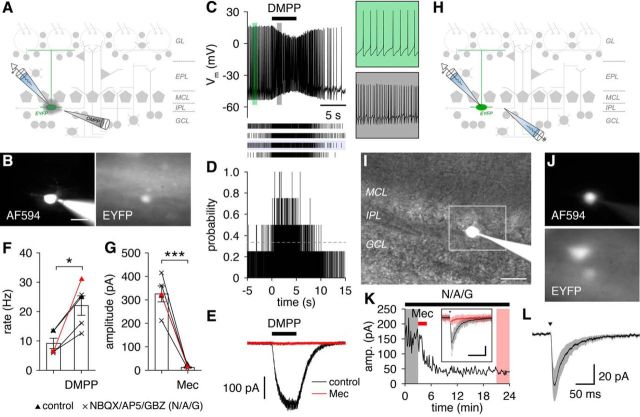Figure 10.
GL-dSACs exhibit nicotinic responses to endogenous ACh release. A, GL-dSAC activity was recorded during focal application of broad-spectrum nicotinic agonist DMPP. B, Whole-cell recording of a representative EYFP-expressing GL-dSAC. Scale bar, 20 μm. C, D, Focal application of DMPP consistently increased the spontaneous firing rate of the cell shown in B. Results are plotted as in Figure 6. Insets, Magnification of 1-s-long periods of firing before and during DMPP appplication. E, Voltage-clamp recording of the mean inward current evoked by DMPP in the cell shown in B. Bath application of Mec abolished the inward current. F, DMPP application significantly increased GL-dSAC spontaneous firing rates (9.2 ± 3.9 vs 22.0 ± 7.5 Hz, before vs during DMPP application; n = 5; p = 0.013, two-tailed paired t test). Red points denote cell shown in B–E. G, Mec blocked the DMPP-evoked inward current in GL-dSACs, leading to a significant reduction in current amplitude (325.5 ± 75.6 vs 12.0 ± 6.1 pA, before vs after Mec application; n = 5; p = 7.3 × 10−4, two-tailed paired t test). Red points denote cell shown in B–E. H, Synaptic input to GL-dSACs was recorded while stimulating the IPL and blocking glutamatergic and GABAergic receptors. I, J, Whole-cell recording of a representative EYFP-expressing GL-dSAC. Scale bar, 20 μm. K, IPL stimulation (10 μA) in the presence of NBQX/AP5/GBZ evoked a robust EPSC in the cell shown in I and J that was abolished rapidly by Mec application. Inset, Mean synaptic response evoked by IPL stimulation (arrowhead) before and after Mec application (scale bar, 100 ms/50 pA). Individual trials are shown in lighter colors. L, Mean postsynaptic nicotinic current recorded in GL-dSACs (peak: 57.7 ± 38.8 pA; decay constant: 29.2 ± 7.2 ms; n = 6) after IPL stimulation (arrowhead; 10–15 μA) calculated by subtracting the mean current after Mec application from the mean current before Mec application (in the presence of NBQX/AP5/GBZ).

